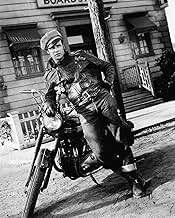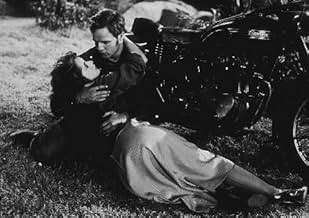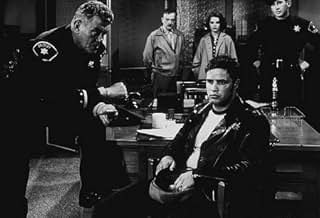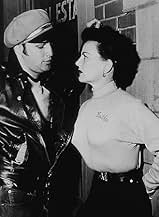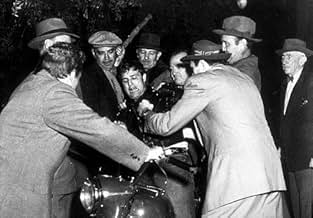IMDb-BEWERTUNG
6,7/10
18.595
IHRE BEWERTUNG
Zwei verfeindete Motorradgangs terrorisieren eine Kleinstadt, nachdem einer ihrer Anführer im Gefängnis gelandet ist.Zwei verfeindete Motorradgangs terrorisieren eine Kleinstadt, nachdem einer ihrer Anführer im Gefängnis gelandet ist.Zwei verfeindete Motorradgangs terrorisieren eine Kleinstadt, nachdem einer ihrer Anführer im Gefängnis gelandet ist.
- Regie
- Drehbuch
- Hauptbesetzung
Wally Albright
- Cyclist
- (Nicht genannt)
Chris Alcaide
- Deputy
- (Nicht genannt)
Don Anderson
- Stinger
- (Nicht genannt)
Robert Anderson
- Highway Patrolman at Sage Valley Race
- (Nicht genannt)
Robert Bice
- Wilson
- (Nicht genannt)
Empfohlene Bewertungen
Would this movie still be watched but for Brando's performance? I think not - it would be relegated to the scrap heap of old B movies. But Brando carries the movie by having the right qualities to play Johnny Strabler, the leader of a motorcycle gang that creates havoc in a small California town. Brando plays Johhny with sullen, smoldering rebelliousness with a suggestion of depth and vulnerability underneath. Brando had already shown his abilities in "A Streetcar Named Desire" and was soon to make "On the Waterfront." The performance here is not up to those standards, but it is engaging. At the time he made this movie Brando's star power was such that he could name his roles, so it is interesting to speculate why he chose to make this. Maybe this role appealed to his own rebellious spirit.
The movie is dated for sure, but you may learn some things about the 1950s that you won't find in the history books. Many early 50s anachronisms are in evidence: 78 records on the jukebox, references to television as being new, bebop music and argot, local HUMAN telephone operators. The comment the old bartender makes about the advent of TV is prescient, "Everything is noise and pictures, nobody talks to anyone anymore" - there is more truth to that with each passing decade. The score - generic, loud, obvious, and intrusive - would not be accepted in contemporary movies. Johnny's attempt to be cool by snapping his fingers to music on the jukebox is so phony as to be embarrassing. One interesting thing was to see an early version of the high-five in response to the interjection "pop me." But credit must be given for this being one of the first mainstream movies to treat the rebellion against the claustrophobic conformity and cold war angst of the early 50s. It was unique for its time.
We do not get much motivation for the reasons the gang members behave the way they do. There are mighty few specifics about the guys in the gang - where they come from, how they support themselves, or what they do besides terrorize small towns. We get only a hint of Johnny's past when, during a beating by the locals he says, "My old man used to hit harder than that." But, maybe all we need to know comes from Johnny's extolling the feeling he gets when getting on his cycle to "just go."
There are many memorable scenes, like the one where Johnny is asked if he doesn't want to thank some people who have done him a good deed and he comes to an inarticulate stop only to have his woman friend say, "That's okay, he doesn't know how."
Lee Marvin has a good go playing Chino, the head of a rival gang that had split off from Johnny's. Chino is the more stereotypical bad ass. He may not have the complex personality of Johnny, but Marvin seems to be having such a grand time in playing him that it is hard not to share in the fun.
There is some interesting photography such as the opening scene where the cyclists roar right over the camera placed in the center of the road. And there is some good night-time black and white work as well.
In an era of drive-by shootings, heavy drug trafficking, and internet pornography the events in this movie can seem pretty tame, but one should not underestimate the number of themes addressed - ones that are still relevant: standing up to intimidation, vigilantism, the desire for freedom, misinterpretation of behavior (with unfortunate consequences), the proper use of force, sex, crowd behavior, generational conflicts and confusions, the ills of stereotyping, and greed.
Also, one lesson to be learned is that steatopygous actors should not wear tight jeans.
The movie is dated for sure, but you may learn some things about the 1950s that you won't find in the history books. Many early 50s anachronisms are in evidence: 78 records on the jukebox, references to television as being new, bebop music and argot, local HUMAN telephone operators. The comment the old bartender makes about the advent of TV is prescient, "Everything is noise and pictures, nobody talks to anyone anymore" - there is more truth to that with each passing decade. The score - generic, loud, obvious, and intrusive - would not be accepted in contemporary movies. Johnny's attempt to be cool by snapping his fingers to music on the jukebox is so phony as to be embarrassing. One interesting thing was to see an early version of the high-five in response to the interjection "pop me." But credit must be given for this being one of the first mainstream movies to treat the rebellion against the claustrophobic conformity and cold war angst of the early 50s. It was unique for its time.
We do not get much motivation for the reasons the gang members behave the way they do. There are mighty few specifics about the guys in the gang - where they come from, how they support themselves, or what they do besides terrorize small towns. We get only a hint of Johnny's past when, during a beating by the locals he says, "My old man used to hit harder than that." But, maybe all we need to know comes from Johnny's extolling the feeling he gets when getting on his cycle to "just go."
There are many memorable scenes, like the one where Johnny is asked if he doesn't want to thank some people who have done him a good deed and he comes to an inarticulate stop only to have his woman friend say, "That's okay, he doesn't know how."
Lee Marvin has a good go playing Chino, the head of a rival gang that had split off from Johnny's. Chino is the more stereotypical bad ass. He may not have the complex personality of Johnny, but Marvin seems to be having such a grand time in playing him that it is hard not to share in the fun.
There is some interesting photography such as the opening scene where the cyclists roar right over the camera placed in the center of the road. And there is some good night-time black and white work as well.
In an era of drive-by shootings, heavy drug trafficking, and internet pornography the events in this movie can seem pretty tame, but one should not underestimate the number of themes addressed - ones that are still relevant: standing up to intimidation, vigilantism, the desire for freedom, misinterpretation of behavior (with unfortunate consequences), the proper use of force, sex, crowd behavior, generational conflicts and confusions, the ills of stereotyping, and greed.
Also, one lesson to be learned is that steatopygous actors should not wear tight jeans.
Brando is his archetypal mean and moody self, as the original rebel on a motorcycle terrorising smalltown America. The enduring iconic images from the film have weathered better than the film itself, however, but it still stands up as a paean to disaffected youth.
When Johnny and the boys ride into town all hell breaks loose, with a culture clash between themselves and the 'squares', resulting in tragedy and some reconciliation. These boys look tame compared to today's standards (they even pay for their own beer!) but they don't fit in and so are immediately ostracised by a grown-up world that doesn't understand their jive-talking, anti-social behaviour. Johnny's reply when asked, "What are you rebelling against?" says it all..."Whatta you got?", with a sneer for good measure.
Time hasn't been kind to the film, and it's hard to see why it was banned in the UK for 18 years (mainly down to the lack of any retribution for the gang), but there is still a tight story and strong characterisation. It's a pity the film descends needlessly into melodrama, losing much of it's credibility in the process.
When Johnny and the boys ride into town all hell breaks loose, with a culture clash between themselves and the 'squares', resulting in tragedy and some reconciliation. These boys look tame compared to today's standards (they even pay for their own beer!) but they don't fit in and so are immediately ostracised by a grown-up world that doesn't understand their jive-talking, anti-social behaviour. Johnny's reply when asked, "What are you rebelling against?" says it all..."Whatta you got?", with a sneer for good measure.
Time hasn't been kind to the film, and it's hard to see why it was banned in the UK for 18 years (mainly down to the lack of any retribution for the gang), but there is still a tight story and strong characterisation. It's a pity the film descends needlessly into melodrama, losing much of it's credibility in the process.
There's really not much to the story. A motorcycle gang, led by Johnny Strabler (Marlon Brando), roars into a small town and kicks up a ruckus. The older townsfolk don't take kindly to the invasion, and Johnny becomes the object of their wrath. But Johnny is smitten with a young woman who happens to be a cop's daughter. "The Wild One" is a character study of a moody young man who starts out as a juvenile delinquent but changes as the result of a sad, mournful young woman.
Costumes play a big part in this film. Motorcycle gang members wear jeans, T-shirts, motorcycle caps, and heavy leather jackets. That's their uniform, which visually defines their rebellion. Johnny starts out in a leather jacket, and ends up in one. I don't think he ever takes it off through the whole film.
Visuals convey the impression that most of the film was shot on studio back lots. The streets and buildings all look fake. And the cinematography is helped not at all by the use of rear screen projection. Yet, the B&W lighting is quite good, especially in the second half, with high contrast noir lighting.
The film's score is annoying. I could have wished for some early 1950's songs. Plot pacing is poor. And the casting of some of the motorcycle gang is laughable. Some of the "juveniles" appear to be at least 30 or 35 years old.
"The Wild One" is remembered mostly as a cinematic vehicle for Marlon Brando, and because the film was something of a trend setter, in that it helped usher in an era of films about American juvenile delinquents, youthful rebel outcasts who didn't fit in to the post WWII era of middle-America family values.
Costumes play a big part in this film. Motorcycle gang members wear jeans, T-shirts, motorcycle caps, and heavy leather jackets. That's their uniform, which visually defines their rebellion. Johnny starts out in a leather jacket, and ends up in one. I don't think he ever takes it off through the whole film.
Visuals convey the impression that most of the film was shot on studio back lots. The streets and buildings all look fake. And the cinematography is helped not at all by the use of rear screen projection. Yet, the B&W lighting is quite good, especially in the second half, with high contrast noir lighting.
The film's score is annoying. I could have wished for some early 1950's songs. Plot pacing is poor. And the casting of some of the motorcycle gang is laughable. Some of the "juveniles" appear to be at least 30 or 35 years old.
"The Wild One" is remembered mostly as a cinematic vehicle for Marlon Brando, and because the film was something of a trend setter, in that it helped usher in an era of films about American juvenile delinquents, youthful rebel outcasts who didn't fit in to the post WWII era of middle-America family values.
Although it might look quite tame compared to todays standards at the time of it's release The Wild One was considered ground breaking stuff which upset it's fair share of people (it was banned in Britain for 14 years). However it helped inspire the era of rebellion which lead to such classics as the James Dean epic Rebel Without a Cause. It is also memorable for Brando giving one of his greatest performances as Johnny Strabler, leader of the rebellious biker gang the "Black Rebels". True he didn't receive an academy award nomination for his role but there's still no doubting the standard of his performance.
At the start of the film we are introduced to Johnny and his gang as they interrupt a race taking place. This leads to a confrontation with the local sheriff which results in them leaving elsewhere to cause trouble. However just as they leave one of the members of the gang steals a trophy that would be presented to the runner up of the race (the first prize trophy was too big to steal)and gives it to Johnny. This represents the respect the gang has for Johnny. Soon after the gang arrives in the small town of Wrightsville, it is here that the film divides into two stories. The first one focuses on the relationship that develops between Johnny and a local girl called Kathie. At first it appears that the two couldn't be anymore different, he's a rebellious free spirit and she's lead quite a sheltered life going by rules and discipline. But it is through Kathie that we get to know the real Johnny as it is revealed that behind all the macho bravado he is quite a lost insecure soul unable to emotionally communicate with anyone, which explains why he behaves as he does. It is a credit to Brando's performance as to how he is able to draw sympathy from the viewer for his character. As Kathie has lead a sheltered life she has always been looking in from the outside, she has a father who is the sheriff of the town but isn't respected by the other residents and is considered something of a joke.It seems he is just there to make up the numbers and shows no signs of law enforcement skills when called to deal with a problem. Kathie sees him as a fraud, just as she sees Johnny. The second story focuses on the conflict that develops between the residents of the town and Johnny and his gang,during which it is the residents of the town who come off as the bad guys and not the black rebels.
As i previously mentioned while this film might look quite tame compared to todays standards it is still worth a look if you get a chance. If not to see what all the fuss was about at the time, then just for Brando's performance which really is in a league of it's own.
At the start of the film we are introduced to Johnny and his gang as they interrupt a race taking place. This leads to a confrontation with the local sheriff which results in them leaving elsewhere to cause trouble. However just as they leave one of the members of the gang steals a trophy that would be presented to the runner up of the race (the first prize trophy was too big to steal)and gives it to Johnny. This represents the respect the gang has for Johnny. Soon after the gang arrives in the small town of Wrightsville, it is here that the film divides into two stories. The first one focuses on the relationship that develops between Johnny and a local girl called Kathie. At first it appears that the two couldn't be anymore different, he's a rebellious free spirit and she's lead quite a sheltered life going by rules and discipline. But it is through Kathie that we get to know the real Johnny as it is revealed that behind all the macho bravado he is quite a lost insecure soul unable to emotionally communicate with anyone, which explains why he behaves as he does. It is a credit to Brando's performance as to how he is able to draw sympathy from the viewer for his character. As Kathie has lead a sheltered life she has always been looking in from the outside, she has a father who is the sheriff of the town but isn't respected by the other residents and is considered something of a joke.It seems he is just there to make up the numbers and shows no signs of law enforcement skills when called to deal with a problem. Kathie sees him as a fraud, just as she sees Johnny. The second story focuses on the conflict that develops between the residents of the town and Johnny and his gang,during which it is the residents of the town who come off as the bad guys and not the black rebels.
As i previously mentioned while this film might look quite tame compared to todays standards it is still worth a look if you get a chance. If not to see what all the fuss was about at the time, then just for Brando's performance which really is in a league of it's own.
MARLON BRANDO rides into town leading a pack of wild motorcycle riders who proceed to terrorize a hick town before LEE MARVIN shows up and gets into a drunken fight with Brando (as Johnny). Meantime, Johnny flirts dangerously with a cop's daughter (MARY MURPHY) who runs a cafe. Her father is played by ROBERT KEITH, a lawman who's reticent about using his authority with a bunch of motorcycle thugs.
Tension builds when Keith manages to haul Lee Marvin off to jail. Brando's buddies manage to get a hold of one of the town bullies and put him in the jail cell with the drunken Marvin who has passed out. They then go on a wild rampage but not before some of the town's men decide to form a vigilante squad and go after Brando. Brando has a brief romantic fling with the girl who realizes loving him is a lost cause.
***** POSSIBLE SPOILER AHEAD ***** The plot moves swiftly to a conclusion once the girl is able to convince the authorities that he wasn't responsible for the death of an elderly bystander hit by a motorcycle.
Stanley Kramer production has a nice, tense background score by Leith Stevens.
Summing up: Early Brando is impressive to watch, but much of the dialog is very dated and anchored firmly in the 1950s by the slang and be-bop expressions and overall concept of the film.
Famous for the moment when a girl taunts him with: "What are you rebelling against?"
Brando's terse reply: "What have you got?"
Tension builds when Keith manages to haul Lee Marvin off to jail. Brando's buddies manage to get a hold of one of the town bullies and put him in the jail cell with the drunken Marvin who has passed out. They then go on a wild rampage but not before some of the town's men decide to form a vigilante squad and go after Brando. Brando has a brief romantic fling with the girl who realizes loving him is a lost cause.
***** POSSIBLE SPOILER AHEAD ***** The plot moves swiftly to a conclusion once the girl is able to convince the authorities that he wasn't responsible for the death of an elderly bystander hit by a motorcycle.
Stanley Kramer production has a nice, tense background score by Leith Stevens.
Summing up: Early Brando is impressive to watch, but much of the dialog is very dated and anchored firmly in the 1950s by the slang and be-bop expressions and overall concept of the film.
Famous for the moment when a girl taunts him with: "What are you rebelling against?"
Brando's terse reply: "What have you got?"
Wusstest du schon
- WissenswertesThe Triumph motorcycle that Marlon Brando rides in the movie was his personal bike.
- PatzerAt the completion of the opening credits, when the view switches to the wide shot of the pack preparing to make a left turn, the lead bike (Johnny) already has the trophy tied to the headlight. Johnny isn't presented with the stolen trophy until a later scene at the races.
- Crazy Credits[Opening credit] This is a shocking story. It could never take place in most American towns -- But it did in this one.
It is a public challenge not to let it happen again.
- VerbindungenEdited into Heavy Petting (1989)
Top-Auswahl
Melde dich zum Bewerten an und greife auf die Watchlist für personalisierte Empfehlungen zu.
Details
- Laufzeit1 Stunde 19 Minuten
- Farbe
- Seitenverhältnis
- 1.37 : 1
Zu dieser Seite beitragen
Bearbeitung vorschlagen oder fehlenden Inhalt hinzufügen






